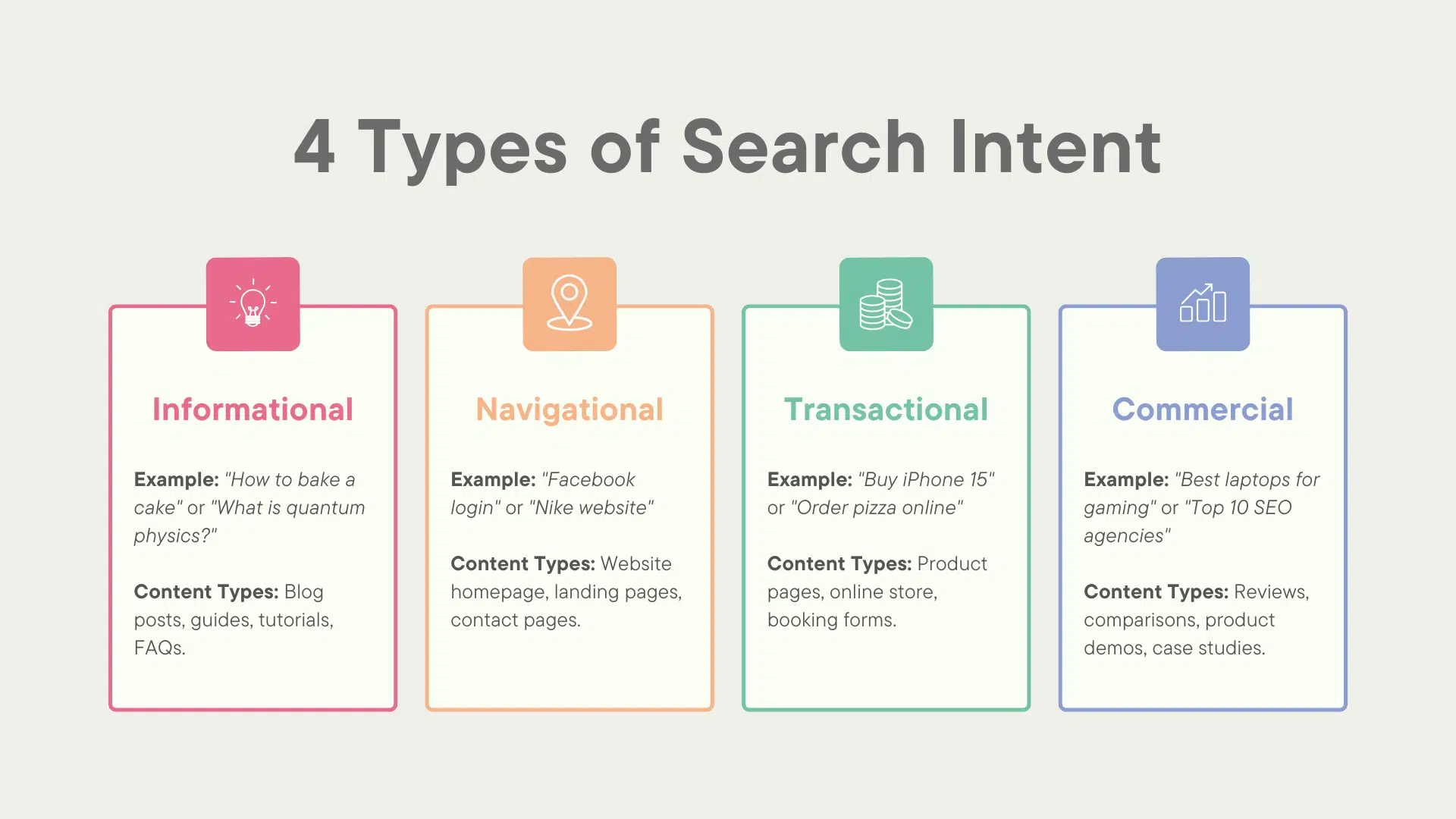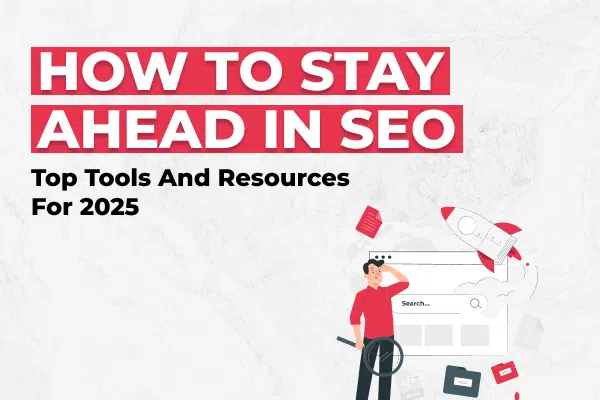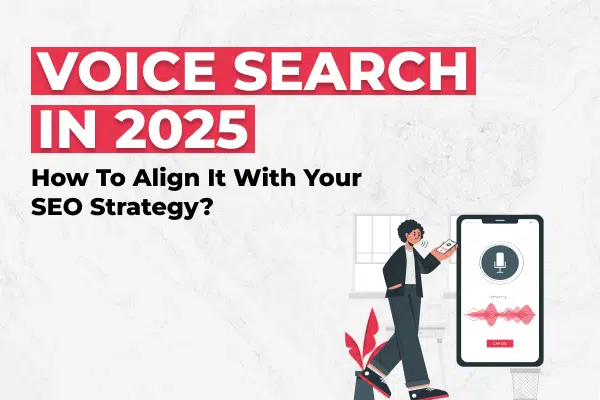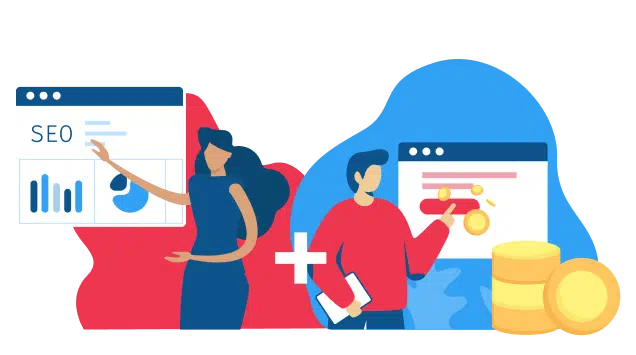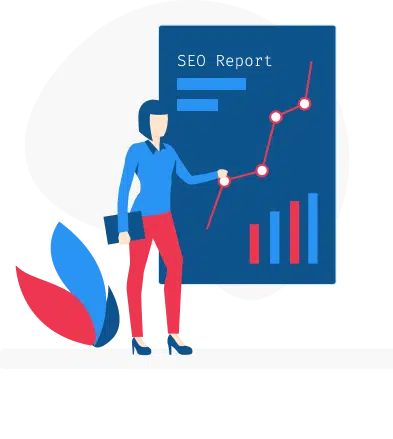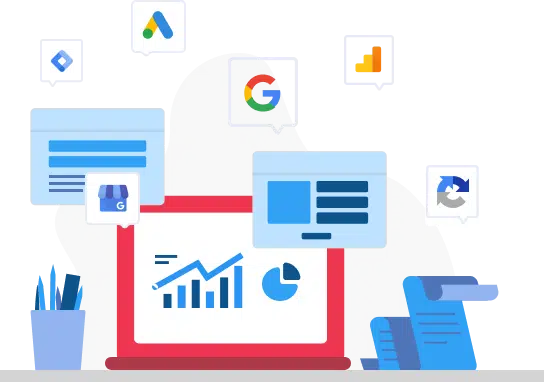Content
- Introduction
- What Is Search Intent in SEO?
- Why Search Intent Matters for SEO
- Search Intent Trends in SEO to Watch for in 2025
- Developing an SEO Strategy Focused on Search Intent
- Benefits of Partnering with an SEO Agency
- Conclusion
Introduction
You’ve crafted the perfect SEO strategy, spent hours on keyword research, and poured your heart into creating amazing content.
Despite all your efforts, your organic rankings and conversions are hardly improving.
What could have gone wrong?
The answer likely lies in one crucial concept: search intent.
Search engines like Google and Bing are constantly evolving. They are becoming more sophisticated at understanding what users really want when they type a query.
This means your SEO strategy needs to go beyond just stuffing keywords into your content. It needs to align with the why behind those keywords.
In other words, new search intent trends in SEO (Search Engine Optimization) are emerging.
This continuous transformation is drastically changing the way businesses approach SEO to make their business or content visible on Search Engine Result Pages (or SERPs).
Today, search intent has gone beyond just inputting keywords into the content.
In this blog, we’ll explore what search intent is, and why it’s essential. We hope that the understanding of this concept will help you redefine your SEO content strategy for search intent.
What Is Search Intent in SEO?
Search intent (or user intent) is the purpose for which a user wants to search for a term or query. It’s the driving force that makes them type specific words into a search engine.
Think of it as the “why” behind the “what.”
Conventionally, there are 4 broad categories of search intents.
The Four Types of Search Intent
We’ve broken down the four types of search intent and suggested the best content formats to engage users at each stage of their journey with your business.
1. Informational: Users want to learn something or find answers.
- Example: “How to bake a cake” or “What is quantum physics?”
- Content Types: Blog posts, guides, tutorials, FAQs.
2. Navigational: Users want to find a specific website or location.
- Example: “Facebook login” or “Nike website”
- Content Types: Website homepage, landing pages, contact pages.
3. Transactional: Users are ready to buy or take action.
- Example: “Buy iPhone 15” or “Order pizza online”
- Content Types: Product pages, online store, booking forms.
4. Commercial Investigation: Users are researching before making a purchase.
- Example: “Best laptops for gaming” or “Top 10 SEO agencies”
- Content Types: Reviews, comparisons, product demos, case studies.
Why Search Intent Matters for SEO
Search engines prioritize content that matches user intent. Here’s why understanding it is crucial:
Improved Rankings
Google wants to provide the most relevant results. Content that aligns with search intent ranks higher.
Enhanced Engagement
When your content answers the user’s question, they’re more likely to stay on your page, read more, and explore your site.
Higher Conversions
By understanding what users want at each stage of their journey, you can guide them towards taking action (making a purchase, signing up, etc.).
Search Intent Trends in SEO to Watch for in 2025
1. AI-Driven Personalization
Search engines are using AI (Artificial Intelligence) to understand user profiles and deliver hyper-relevant results.
Machine learning algorithms analyze past searches, the links they click on, and the websites they visit. The ML algorithms even assess their locations and interests.
This means that the search engines will show results that are highly relevant to the user.
For example, there is a user who often searches for recipes for vegetarian Indian food.
When they search for “dinner ideas,” Google is likely to show them results for vegetarian Indian dishes, even if you don’t specifically include those keywords in your search.
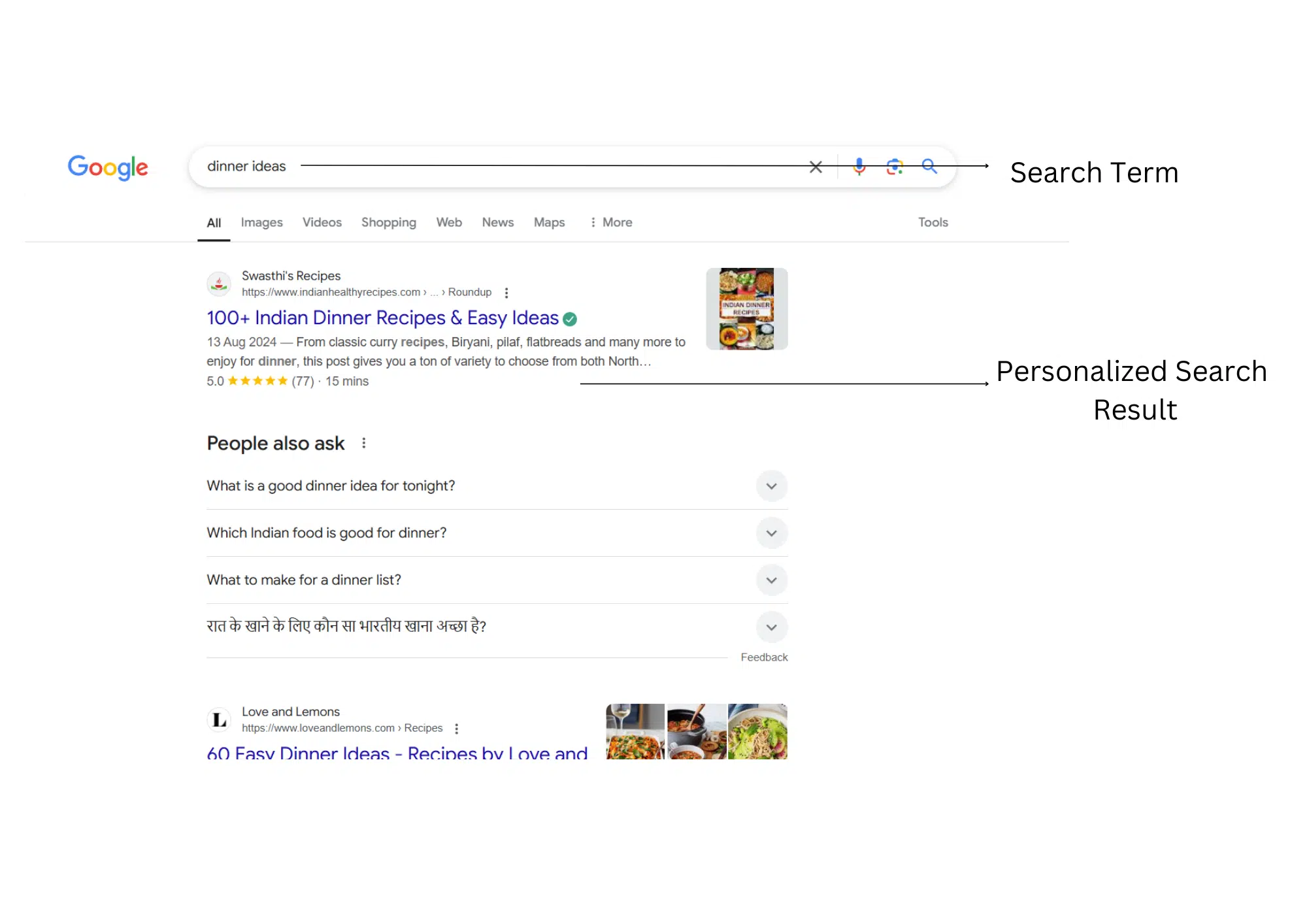
But, how?
AI has learned the user’s preferences and is trying to show them search results related to their interests.
To put it in better words, search results are becoming more personalized than ever before.
Why does it matter to you?
Two people searching for the same thing might see different results based on their individual preferences and search history.
In other words, it has become even more important to create content that truly matches the needs of your target audience.
Consider again the user who frequently searches for Indian vegetarian recipes.
To ensure that your content reaches a similar audience, you need to optimize the content accordingly.
Here’s how:
- Use relevant keywords: Include terms like “vegetarian,” “Indian,” and specific dish names.
- Provide context: Explain the cultural significance of the dishes or offer variations for different dietary needs.
- Address niche needs: Create recipes for specific occasions or dietary restrictions (e.g., “vegan gluten-free Indian desserts”).
In short, focusing on context and specific needs of the target audience boosts the visibility of your content to the people you want to engage with your content.
2. Voice Search Optimization
Voice assistants such as Siri, Alexa, and Google Assistant are becoming increasingly popular for web searches. People speak naturally to them, just like they’re talking to a person.
In other words, people use longer phrases, full sentences, and often ask questions when they use the voice search feature.
Example queries:
- “What’s the best SEO company near me?”
- “How can I improve my site’s ranking?”
- Instead of “SEO,” people might ask “best SEO agency in Dubai.”
If your website is only optimized for traditional text searches (short, keyword-focused phrases), you might miss out on voice search traffic.
Focus on optimizing your content for natural language by using long-tail keywords.
To summarize, use full sentences, conversational language, and a natural tone. Moreover, make sure your content provides clear and concise answers to common questions related to your topic.
3. Add Graphics: SEO for Visual Search
People aren’t just typing words into search engines anymore. They’re using images too!
Tools like Google Lens (which is now widely available on phones and browsers) allow users to search using their camera.
For example, you can take a picture of a landmark to learn about it, or snap a photo of a product to find where to buy it.
If your website relies only on text, you could be missing out on this growing trend.
Search engines need to understand what your images are about so they can show them in relevant visual searches.
To expand your online reach, include relevant images, illustrations, and infographics in your content. Plus, add alt text to provide context for search engines about the uploaded image.
Don’t forget to optimize the file name of your image file. Use precise filenames to clearly describe your image; for example, “infographic on types of search intent.”
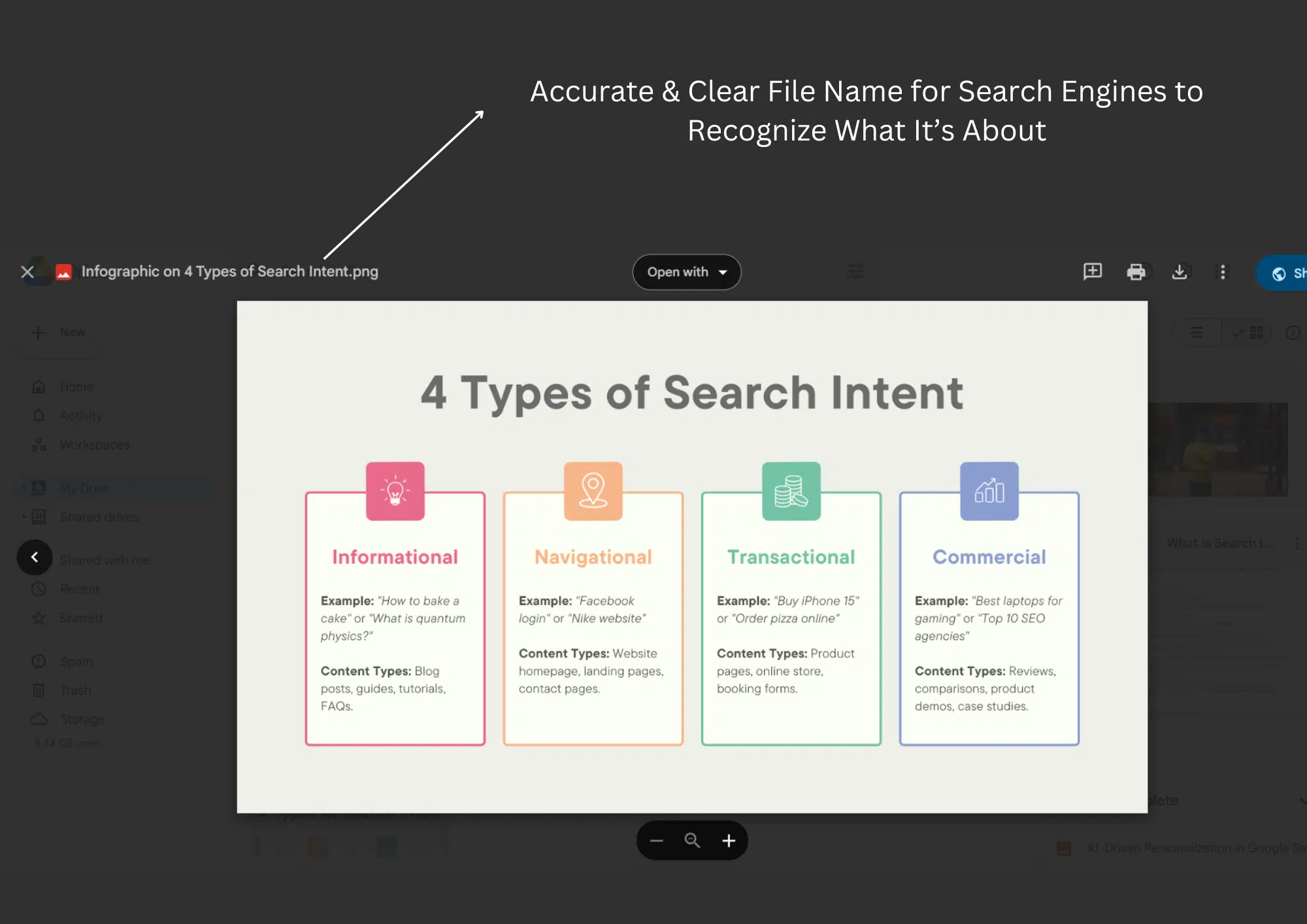
Additionally, use schema markup to provide context for your images, such as subject matter and creator.
4. Focus on User Experience
Search engines like Google focus on providing the easiest possible answers to people’s questions.
This means they prioritize websites that are easy to use, navigate, and understand.
A frustrating or difficult website will lead to quick user exits, a factor that Google considers as a negative signal.
Here’s what you should do:
Focus on key UX factors, like:
- Fast loading speeds: People hate waiting for pages to load. Make sure your website is fast!
- Easy navigation: Make it easy for your website visitors to find what they need quickly and easily.
- Mobile-first design: Most people browse the web on their phones, so your website must be mobile-friendly.
Improve Core Web Vitals: These are metrics that measure how users experience the speed, responsiveness, and visual stability of your website. Google uses them as ranking factors.
Accessibility: Ensure your website is accessible to everyone, including those with disabilities, by using clear headings, alt text for images, and proper color contrast.
Clear and intuitive design: Your website should be visually appealing. Plus, your content should be well-structured and easy to comprehend. To achieve this, use crisp headings, concise text, and an organized layout.
Also read – How Does Content-First Design Help Create A Better User Experience?
5. New SERP Features: “Zero-Click” Searches & More
Search engine results pages (SERPs) are no longer just a list of relevant page links to the search query. They’re becoming more interactive and dynamic, with features that provide answers directly on the results page.
This means people often get the information they need without clicking on any links, hence the term “zero-click searches.”
This trend can significantly impact your website traffic.
If people find answers without clicking on your link, you might get fewer visitors.
However, it also presents an opportunity for prominent SERP feature placement, even without direct clicks.
In 2025, prioritize providing value and achieving SERP feature placement in addition to focusing on clicks.
Aim to get your content into AI overview, Featured snippets, Knowledge panels, and “People Also Ask” boxes.
AI Overview
Google uses AI to summarize information from multiple sources in an overview that appears above featured snippets.
However, the AI overview feature currently appears in less than half of the Google searches.
Strategies for getting your webpage selected for AI summary are still developing as this trend is in its early stages.
In other words, the AI-overview SEO content strategy for search intent in its early stages.
However, it is seen that AI-generated summaries favor the content that is authoritative, concise, and clearly structured.
Here are some steps to optimize your content for AI overview:
- Use descriptive headlines in your H1, H2, and H3 tags.
- Summarize key information in 40–60 words at the beginning of the page or section. .
- Use schema markup (e.g., FAQ, How-To, or Article) to signal to Google that your content is authoritative and useful for summaries.
Link (add references) of credible websites or reports to establish trustworthiness.
Featured Snippets
Featured snippets are short summaries appearing at the top of the results page, providing concise answers to question-based searches. They usually appear when a user makes a question-based search or queries seeking a direct answer.
How can you get your content featured in a snippet?
- Ensure your content is easy to understand and scan.
- Concisely answer relevant questions within your content.
- Use Google’s preferred formats for snippets, such as bullet points or numbered lists.
- Include the target keyword in the heading and within the first 100 words of your content.
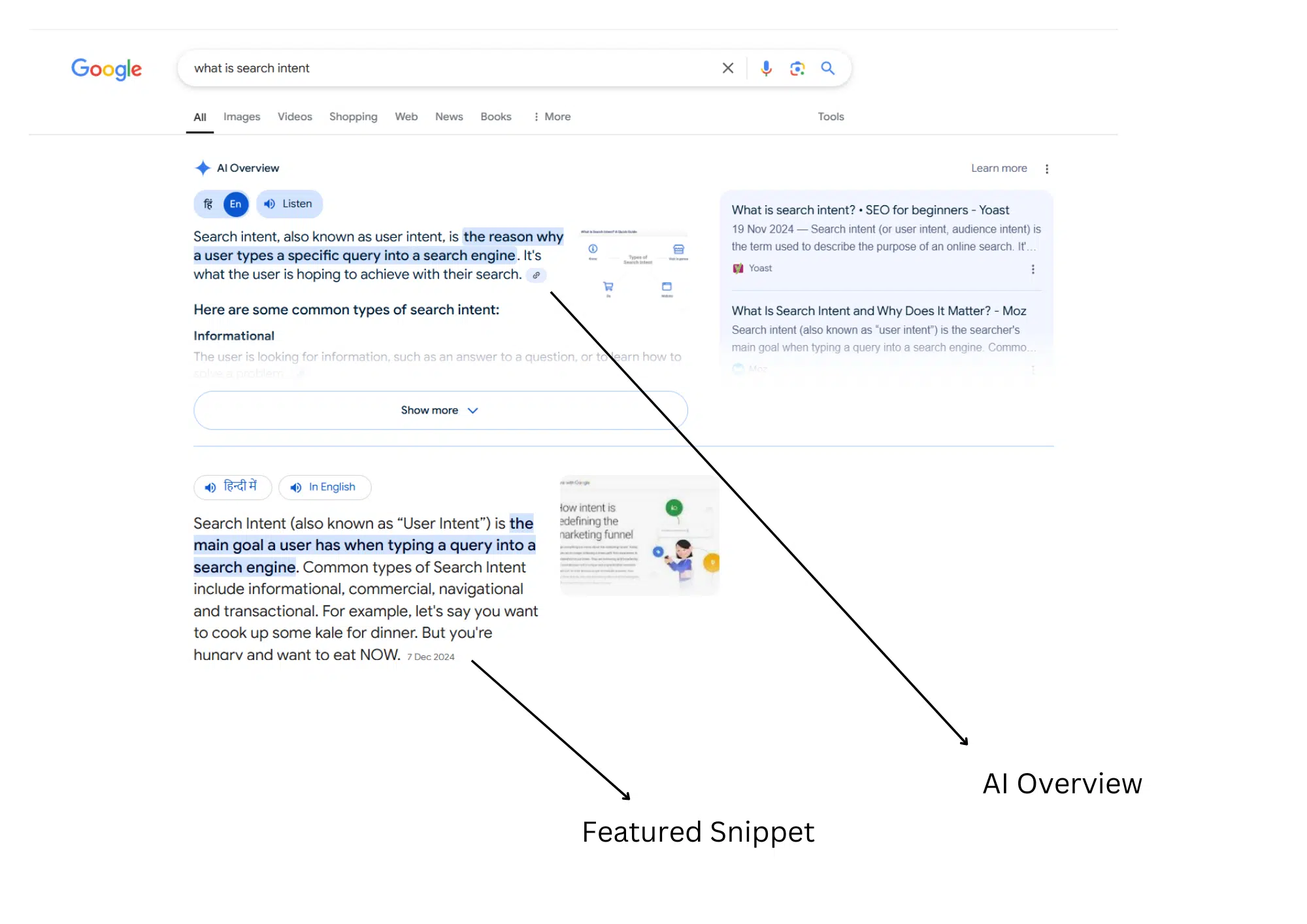
Knowledge Panels
A Knowledge Panel is a box on the right side of search results that provides key information about a person, place, or thing.
To illustrate, let’s consider an example.
So, let’s say you’re searching for something on Google, like “Albert Einstein.”
The search might display a Knowledge Panel on the right side of the results page, featuring his birthdate, a brief biography, famous quotes, and pictures.
That’s a Knowledge Panel!
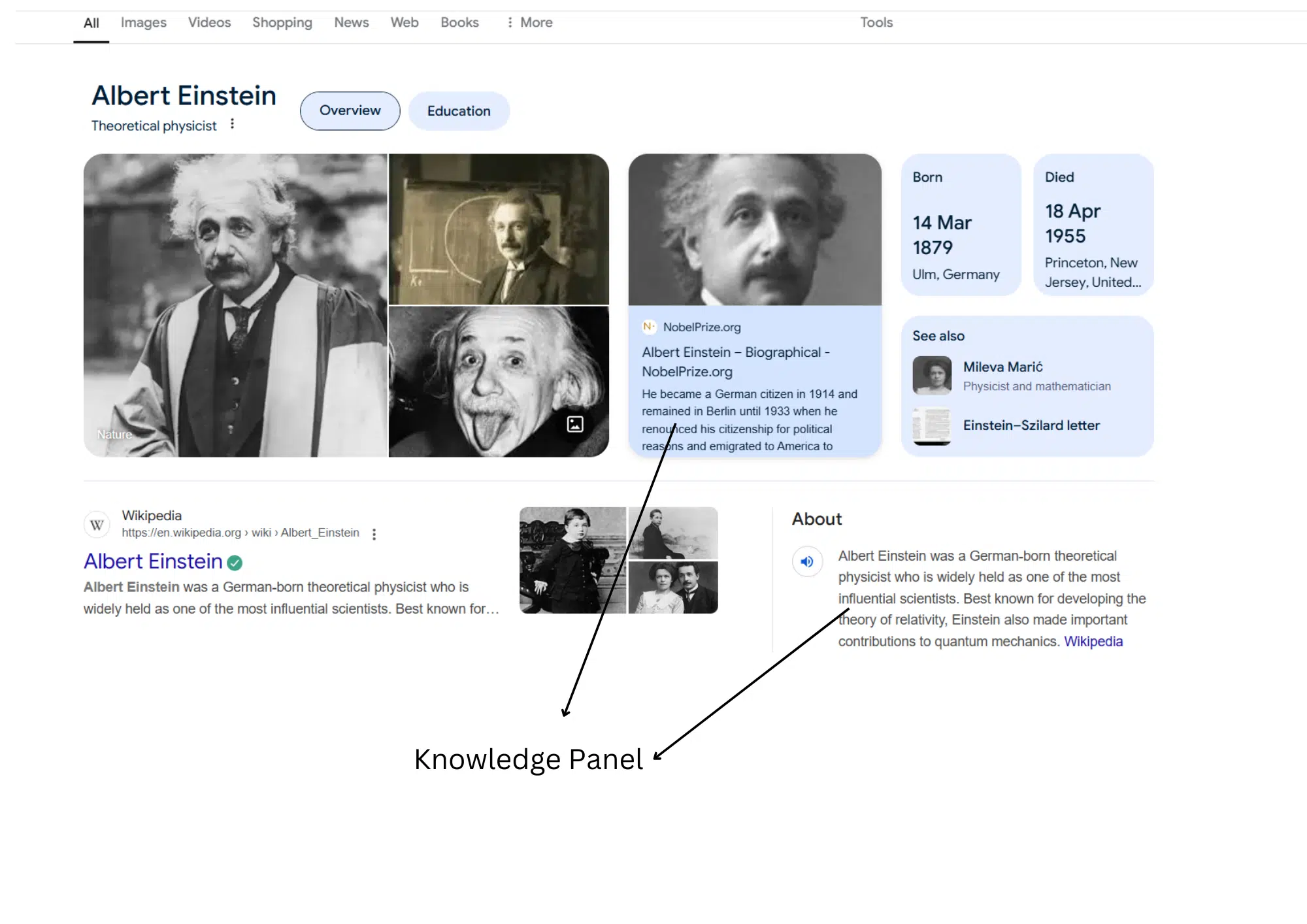
To be featured in a Knowledge Panel, your content must demonstrate expertise and present clear, factual information. Here’s how:
- Demonstrate expertise with high-quality, authoritative, and factually accurate content that is easy to understand.
- Use schema.org markup (e.g., Person, Organization, or FAQ schema) and rich metadata to define your content.
- Create a Google Business Profile and add your information to Wikidata.
- Include high-quality images and infographics with descriptive alt text to improve accessibility and SEO.
- Seek high-quality backlinks from authoritative websites to signal trust and credibility.
| Key Differences Between : Featured Snippet, AI Overview, & Knowledge Panel | ||||
|---|---|---|---|---|
| SERP Feature | Purpose | Source | Trigger | Appearance |
| Featured Snippet | Concise answer | Single webpage | Question-based searches | Highlighted box within search results, potentially at the top of the SERP or below the AI overview. |
| AI Overview | Summarized overview | Multiple webpages (AI-powered) | Informational searches | Top of search results page (when present). |
| Knowledge Panel | Entity information | Knowledge Graph | Searches for specific entities | Box on the right side or top of search results |
“People Also Ask” Boxes
“People Also Ask” (PAA) feature related questions to the original search term or query.
Usually, when a user clicks on a PAA question, it expands into a snippet of a webpage, which Google’s algorithm has sorted as the most apt answer for that particular question.
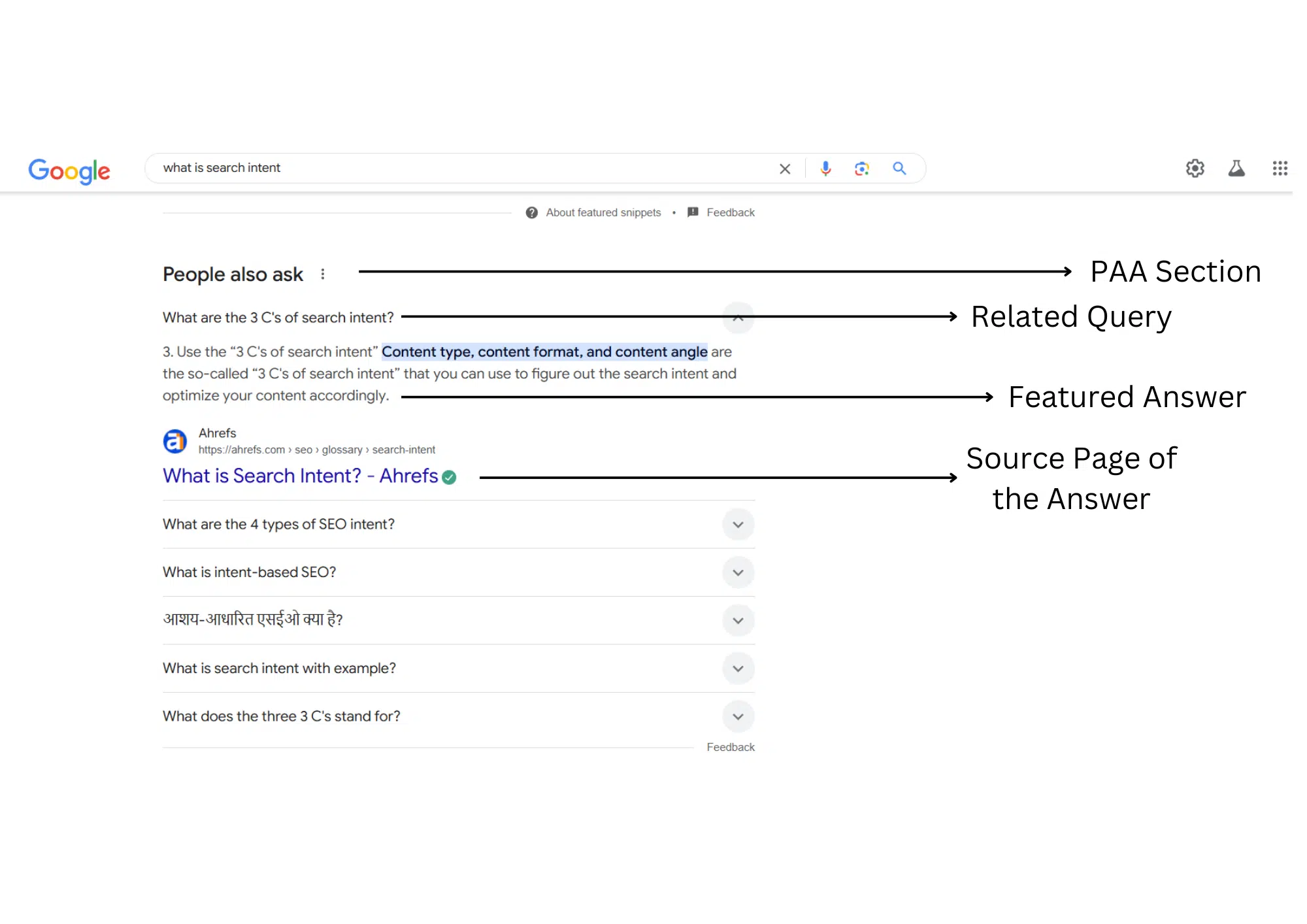
How to crack PAAs? For that, follow the below advice:
- Identify PAA queries related to the targeted keywords of your content.
- Within your piece of content, answer each question in a short paragraph (40–60 words), with clear, actionable information.
- Create an FAQ section on your page, formatted with structured data markup to help Google extract answers.
- Frequently update your answers to ensure they remain relevant and reflect new developments.
6. Emphasis on Entities and Topics
When someone searches for “apple,” are they searching for the fruit, the tech company, or some other brand that has apple in its name?
Search engines are getting smarter. Instead of just looking at individual keywords, they now try to understand the intent and context behind those keywords and how they relate to broader topics.
By understanding the context of your search, Google can show you the most relevant results.
To make the most of this trend, organize your content around key topics and related terms throughout your website. This helps search engines understand what your website is about and establishes you as an expert in your field.
In short, your SEO content strategy for search intent should be like building an online library.
Here’s an example:
Let’s say you have a website about dogs. Instead of just writing separate articles about “dog food,” “dog breeds,” and “dog training,” you could create a content cluster around the topic of “dog care.”
This is how your content cluster around the topic could look like:
| Example of Content Cluster Around the Topic “Dog Care” | ||||
|---|---|---|---|---|
| Page Title | Page Type | Objective | Content Structure | Call to Action |
| Dog Care Basics | Informational Page | Introduce fundamental dog care principles | 1. Overview of dog care 2. Why proper care matters 3. Key aspects: feeding, grooming, exercise, and health care |
Link to detailed guides for each topic |
| Dog Grooming Tips and Tricks | Informational Page | Offer practical grooming advice | 1. Importance of grooming 2. Grooming schedules 3. DIY grooming techniques 4. When to seek professional help |
Link to grooming product recommendations |
| Exercise and Play for a Happy Dog | Informational Page | Highlight the importance of physical and mental stimulation | 1. Benefits of exercise 2. Types of activities 3. Indoor vs outdoor play 4. Tips for an active lifestyle |
Sign up for weekly activity ideas |
| Dog Training Resources | Resource Hub | Provide training guides for new and experienced dog owners | 1. Basic commands 2. Dealing with bad behavior 3. Advanced tricks 4. Training products |
Download free training guides |
| Best Dog Care Products | Product Showcase | Feature top-rated dog care products | 1. Food dispensers 2. Grooming kits 3. Beds and crates 4. Leashes and collars |
Shop the recommended products |
| Puppy Care 101 | Informational Page | Focus on caring for puppies and creating a safe environment | 1. Puppy-proofing your home 2. Feeding and sleeping schedules 3. Early training tips |
Link to puppy-specific product recommendations |
| Adopting a Dog: What to Know | Informational Page | Guide potential adopters on preparing for a new pet | 1. Finding the right breed 2. Preparing your home 3. First steps after adoption |
Contact us for an adoption checklist |
| FAQs About Dog Care | FAQ Page | Address common dog care queries | List common questions like: What food is best? How often do you groom? How much exercise is needed? | Link to contact page for further questions |
Next, link these articles together, and use related terms throughout your website.
This way, you convince search engines that your website is a valuable resource for information about dog care.
This can lead to higher rankings and more organic traffic.
Also read – SEO Strategies: How to Rank Higher on Google?
Developing an SEO Strategy Focused on Search Intent
Aligning your content with search intent requires a methodical approach.
It’s like planning a long road trip with your crew (in this case, your team).
You need to know your destination (the keywords you want to rank for), the different routes you can take (the types of content you can create), and how to navigate along the way (using data and competitor analysis).
Here are some steps that will help you create a content strategy that aligns with search intent and drives results.:
Conduct Intent-Focused Keyword Research
Move beyond just finding popular keywords.
Use tools like SEMrush or Ahrefs to identify keywords and analyze the intent behind them (informational, navigational, transactional, or commercial).
For example, the keyword “best laptops for students” has a commercial investigation intent, while “buy MacBook Air” has a transactional intent.
Create Content for People at Different Stages of their Buying Journey
The buyer’s journey consists of three stages:
Awareness: When people are first learning about a topic, they need informational content.
Keeping long-term goals in focus, create blog posts, guides, and videos that answer fundamental questions, “What are the benefits of ?”
Consideration: Once people are aware of their needs, they start comparing options.
To cater to them, create comparison articles, reviews, and case studies to help them evaluate choices.
Decision: When people are ready to buy, they need transactional content.
Therefore, optimize your product pages for search intent, include clear calls to action, and make it easy for your prospective customers to make a purchase.
Analyze Content of the Competitors
See how your competitors are addressing search intent. What kind of content are they creating? What keywords are they targeting?
Then, identify gaps in their content and opportunities to create something even better.
Leverage Data Analytics
Use tools like Google Analytics to track how people interact with your content.
Additionally, analyze which pages are most popular, how long people stay on them, and what actions they take.
Finally, use this data to refine your strategy and create even more effective content.
Benefits of Partnering with an SEO Agency
Creating a successful SEO content strategy for search intent can be challenging without professional expertise. Here’s how the best SEO company can help:
- Analyze your target audience, industry, and competitors to develop a tailored search intent strategy
- Provide actionable insights using advanced SEO and website analytics tools.
- Deliver results through specialized SEO services, including eCommerce, YouTube, and international SEO.
Conclusion
Understanding and using search intent in your SEO is a “must” if you want to succeed in an online world where search engines are powered by AI.
Lay a strong content foundation by aligning your content with user intent. As a result, you can drive higher rankings, better engagement, and increased conversions (subscriptions and sales).
More importantly, there is a new google update every few months. To keep up the pace, partner with the best SEO agency today! The experts can help you harness the power of search intent and position your business and content at the most visible spot.
Frequently Ask Questions
What are the 3Cs of Search Intent?
The 3 Cs of search intent are:
- Content Type: The dominant type of content in search results (e.g., blog posts, product pages).
- Content Format: The structure and presentation of the content (e.g., how-to guides, listicles, reviews).
- Content Angle: The unique perspective or approach taken (e.g., beginner’s guide, expert analysis, humorous take).
Understanding these helps you create content that aligns with what users are looking for.
What is the SEO of a Website?
SEO stands for Search Engine Optimization. It’s the practice of improving a website to increase its visibility in search engine results. This involves:
- Technical aspects: Optimizing website code and structure.
- Content: Creating high-quality, relevant content.
- Off-page factors: Building links from other websites.
The goal is to attract more organic (non-paid) traffic from search engines.
What is Intent-based SEO?
Intent-based SEO focuses on understanding the why behind a search query. It goes beyond just targeting keywords to consider the user’s goal (e.g., learning, buying, finding a website). This involves:
- Identifying search intent.
- Creating content that satisfies that intent.
- Optimizing for relevant SERP features (e.g., featured snippets).This approach helps create a better user experience and improve rankings.
Why is Search Intent Important for SEO?
Search intent is crucial because:
- Google prioritizes it: Google aims to provide the most relevant results, and understanding intent helps them do that.
- It improves rankings: Content matching intent ranks higher.
- It boosts engagement: Users stay longer when their needs are met.
- It drives conversions: You can guide users toward taking action.Essentially, it’s about aligning your content with what users want.
How to Strategize and Write Content for Search Intent?
- Keyword research: Identify relevant keywords and analyze their intent.
- Content planning: Create content that matches the identified intent.
- Content optimization: Use clear headings, concise language, and relevant visuals.
- SERP feature optimization: Aim to get featured in snippets, knowledge panels, etc.
- Analysis and refinement: Track your results and adjust your strategy accordingly.
By following these steps, you can create content that both users and search engines love.


